|
| A theoretical view of the Hastings Landscape in 1066AD |
|---|
| |
|---|
| Background |
|---|
This page is my interpretation of the Landscape near Hastings in 1066AD based on a number of old maps and the geology of
the area. I will show these maps in descending date order.
|
| |
|---|
| Assumptions ▲ |
|---|
Please note, the reconstruction of the coastline uses the following assumptions:
- That the erosion rate along the coast is constant over time
- That this rate is about 0.8 metres per year
- The old maps show a reasonable representation of the area at the time of their production
- The sea level was about 4 metres higher in 1066AD
- The final map shows the sea level at high tide
- The general geology of the area shows the main rivers going just south of West to East.
|
| The final map of Hastings in 1066AD ▲ |
|---|
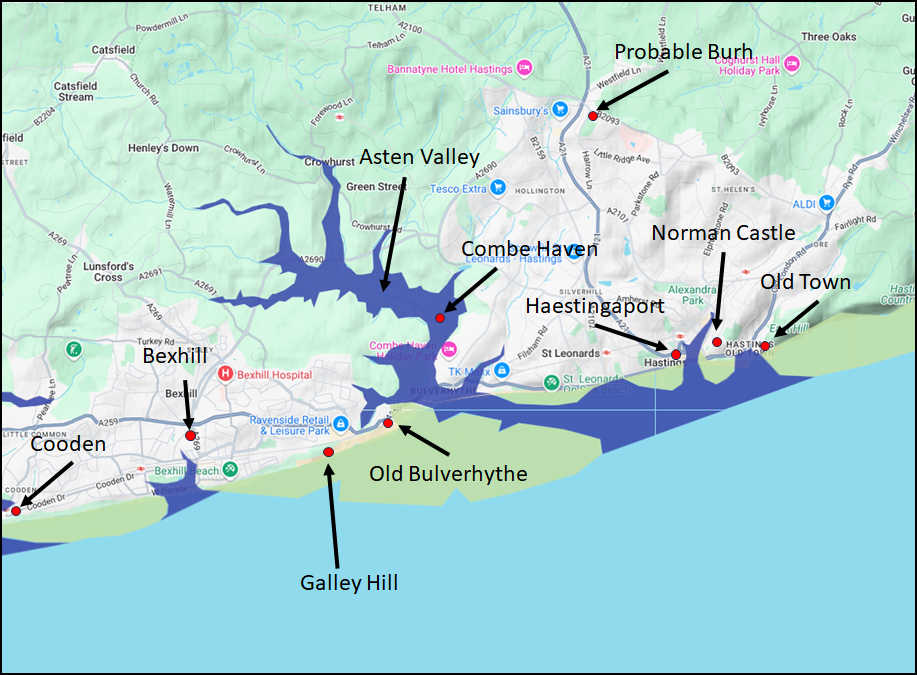 This map is my latest interpretation of the landscape near Hastings in 1066AD and is drawn using Google My maps.
This map is my latest interpretation of the landscape near Hastings in 1066AD and is drawn using Google My maps.
The blue areas show the 4.5 metre coastline, probably the high tide mark at the time. The Green areas off the coast show
eroded land since 1066AD which would probably be about 900 metres out into the English Channel.
The Asten river would have flowed along the coast to Hastings Haven where the modern castle would have over looked the
river entrance, and the entrance to the port which was probably in the area of the modern Priory Road shopping centre.
So what is the evidence for this map, is there any ??
|
| |
|---|
| Lidar map of East Sussex ▲ |
|---|
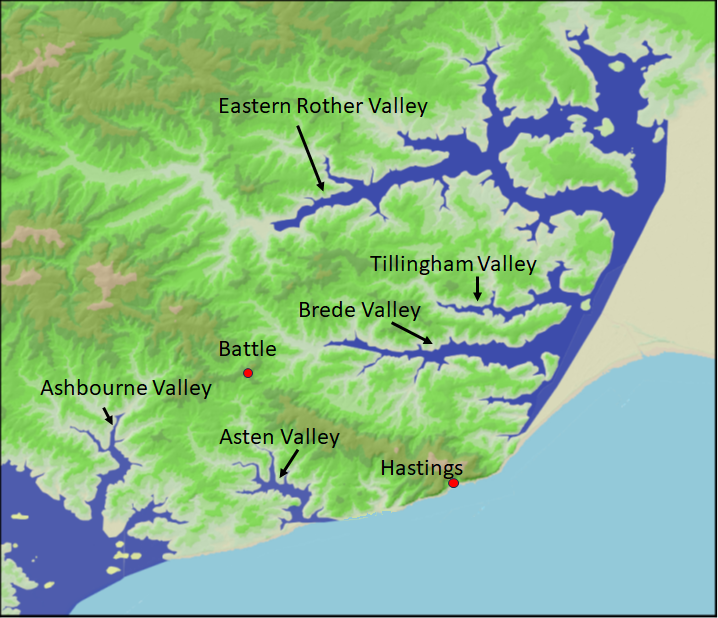
This map shows a Lidar image of East Sussex, which is colour coded for height above sea level, as you can see the hills
roughly go North West to South East with the rivers generally heading towards the South/South East.
The river valleys are shown in blue at a high tide level of about 4 metres to show effects of the sea level without any
sea defences.(see Landscape - Was the sea
level in Saxon times at Pevensey 4 to 5 metres higher ?)
I have omitted the Romney Marsh as this has changed significantly over time, please see our Landscape - The History of the Romney Marsh in maps(Pre-Roman
to Modern times).
The two main towns related to the Battle of Hastings are shown. As you all know the Battle of Hastings was not at
Hastings but at the nearby town of Battle.
|
| Lidar map of the area ▲ |
|---|
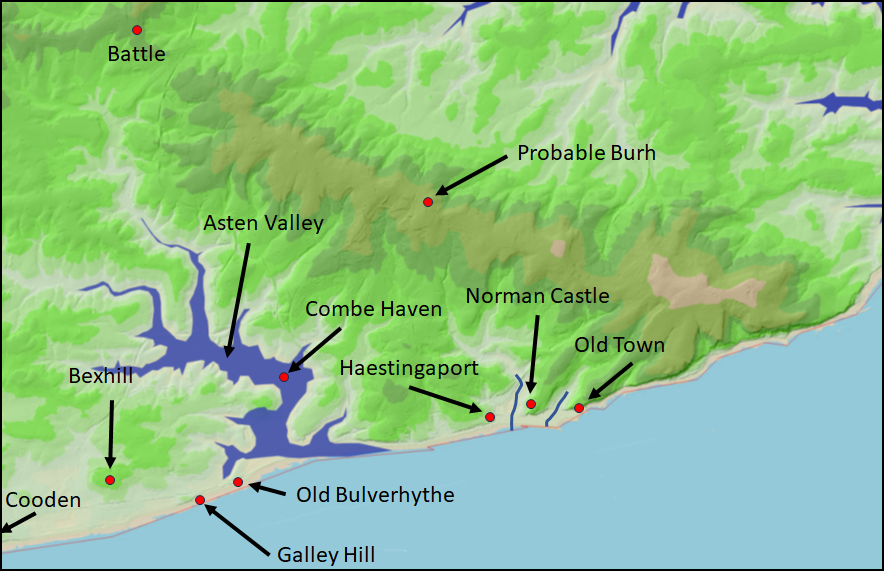 This is a close up Lidar map of the Hastings area showing the prominant ridge that goes from Battle to Fairlight. The
blue lines show the current routes of the Asten river plus the smaller streams around Hastings.
This is a close up Lidar map of the Hastings area showing the prominant ridge that goes from Battle to Fairlight. The
blue lines show the current routes of the Asten river plus the smaller streams around Hastings.
|
| Ordnance Survey 1 inch Popular 1919-1930 ▲ |
|---|
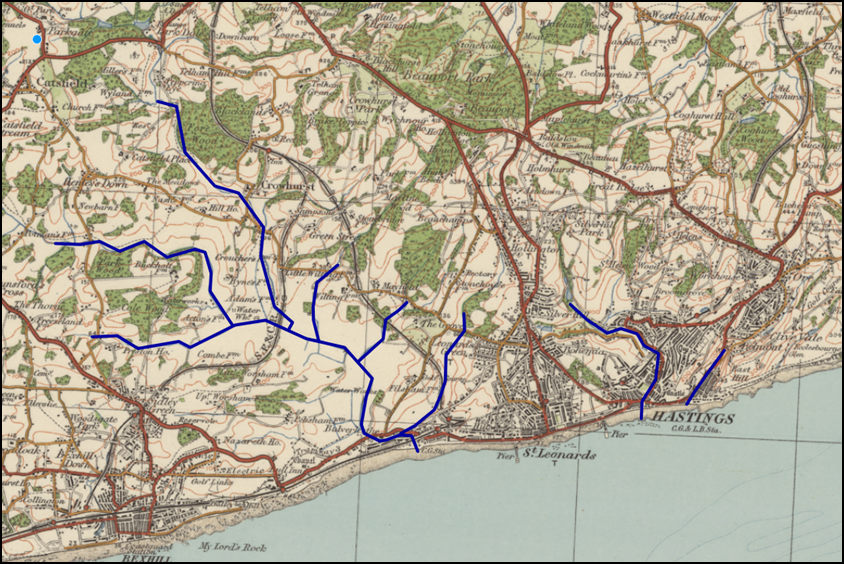 Lets start with a map from the early 1900's, this is an 'Ordnance Survey 1 inch Popular 1919-1930', this map can be seen
by clicking the image above and derives from the 'National Library of Scotland'.
Lets start with a map from the early 1900's, this is an 'Ordnance Survey 1 inch Popular 1919-1930', this map can be seen
by clicking the image above and derives from the 'National Library of Scotland'.
The blue lines show the path of the main streams in the area, and as you can see the Asten river arrives in the Channel
between Bexhill and St leonards in the region of Harley Shute road.
|
| Ordnance Survey Old Series 1 inch published 1813 ▲ |
|---|
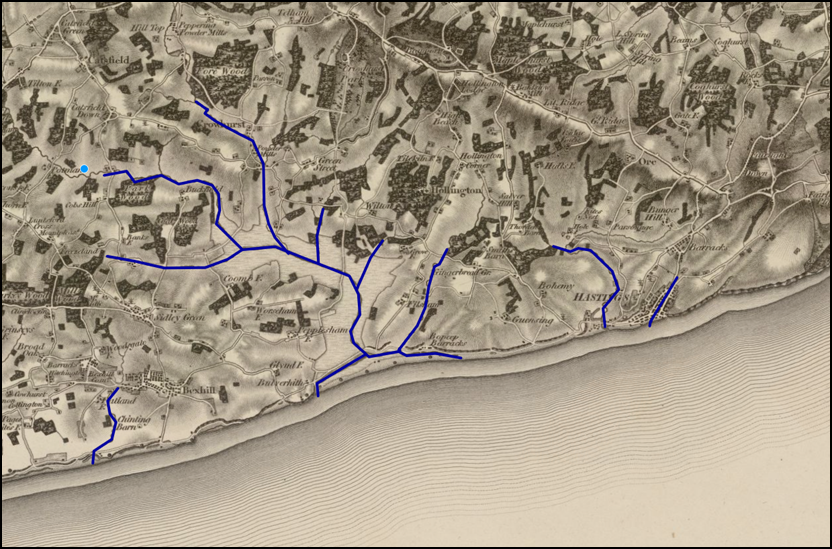 This map now shows that the Asten river reaches the sea both Eastbound towards BoPeep Barracks and West towards Galley
Hill.
This map now shows that the Asten river reaches the sea both Eastbound towards BoPeep Barracks and West towards Galley
Hill.
|
| Yeakell and Gardners map published in 1787AD ▲ |
|---|
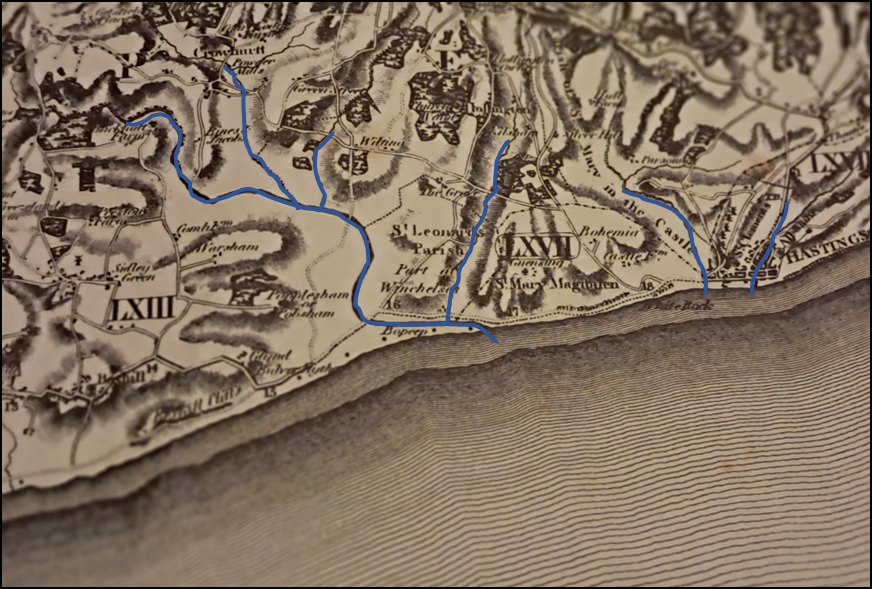 This map now shows that the Asten river reaches the sea towards Hastings by running along the coast at modern St
Leonards.
This map now shows that the Asten river reaches the sea towards Hastings by running along the coast at modern St
Leonards.
|
| Budgen map 1724AD ▲ |
|---|
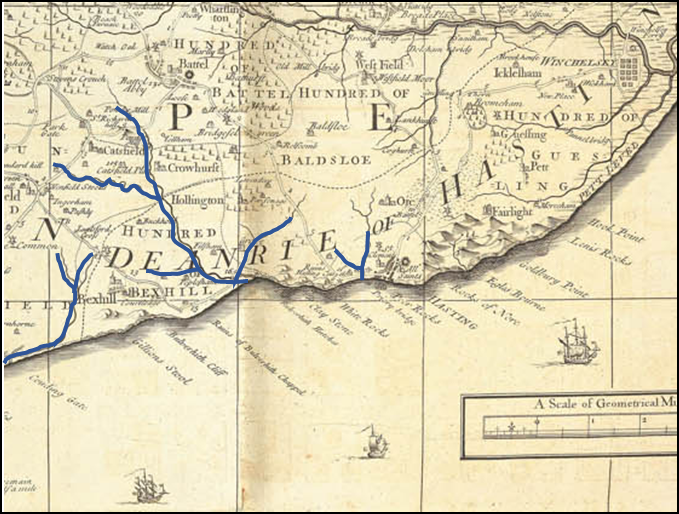 The detailed accuracy is dropping as we go back in time, but the overall is what we are after. The Asten river is still
heading towards Hastings for its outfall.
The detailed accuracy is dropping as we go back in time, but the overall is what we are after. The Asten river is still
heading towards Hastings for its outfall.
|
| John Norden map published in 1695AD ▲ |
|---|
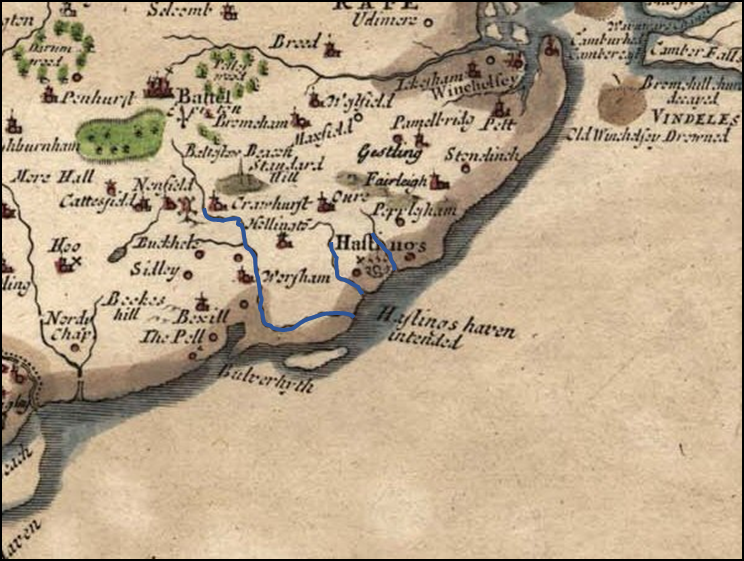 As you can see the accuracy is degrading, but this shows the Asten heading further towards Hastings, but there is now an
island off modern Bulverhythe, which implies a fair bit of erosion.
As you can see the accuracy is degrading, but this shows the Asten heading further towards Hastings, but there is now an
island off modern Bulverhythe, which implies a fair bit of erosion.
|
| John Speed map published in 1610AD ▲ |
|---|
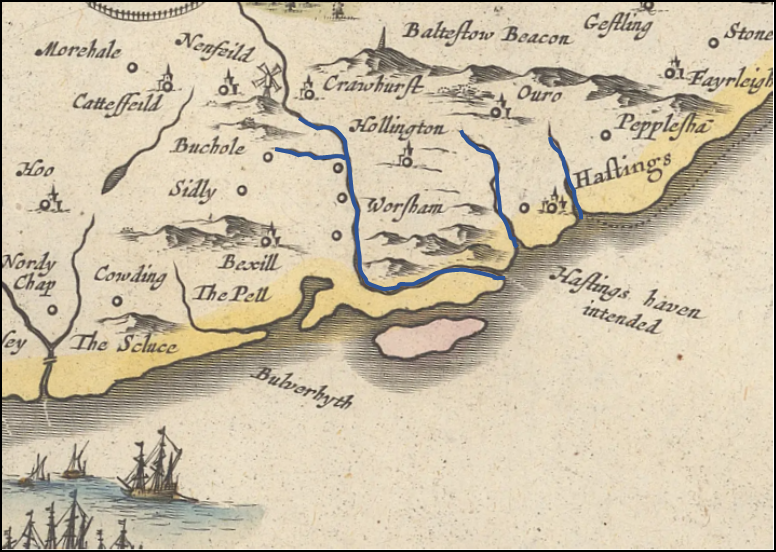 It looks as though Nordens map is just a copy of John Speed's earlier map.
It looks as though Nordens map is just a copy of John Speed's earlier map.
|
| Mercator 1595AD ▲ |
|---|
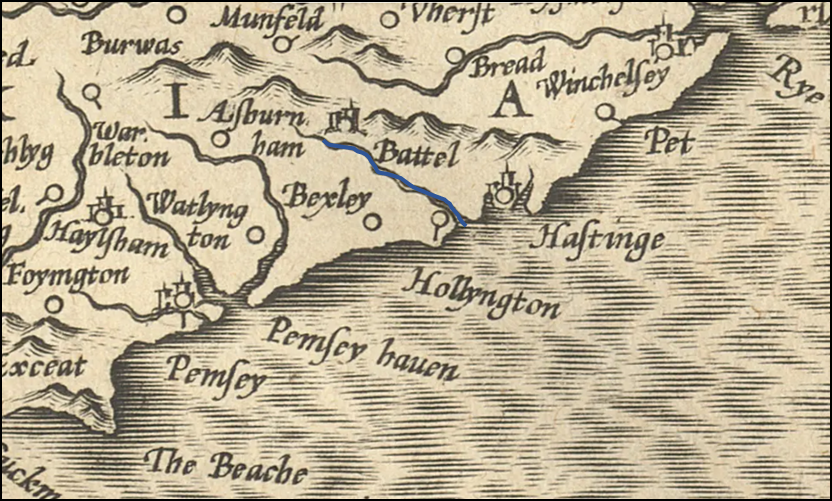 We are now back to 1595AD and have lost the detail, but from this we can see that the area near the Norman Castle at
Hastings stood further out into the channel, but was protected by land offshore of the White Rock and the Old Town.
We are now back to 1595AD and have lost the detail, but from this we can see that the area near the Norman Castle at
Hastings stood further out into the channel, but was protected by land offshore of the White Rock and the Old Town.
|
| Matthäus Seutter 1730AD ▲ |
|---|
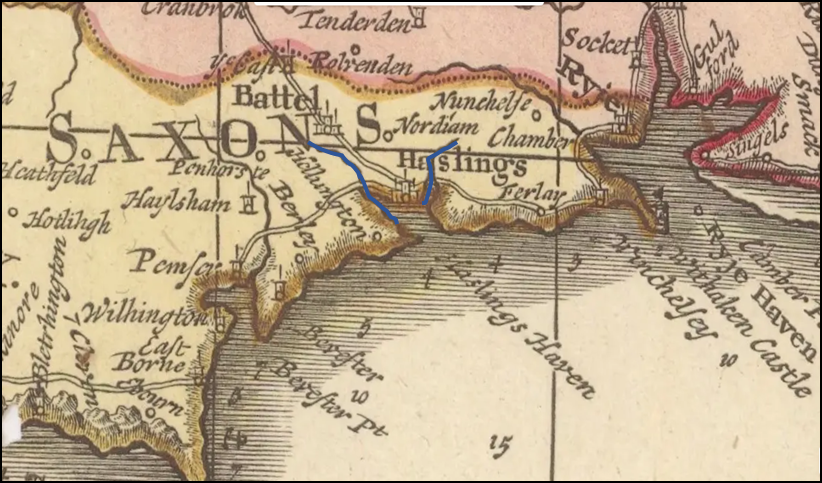 Although this is a later map, it is probably derived from a different original source than the rest of the maps above,
and shows more close up details of Hastings in a protected bay.
Although this is a later map, it is probably derived from a different original source than the rest of the maps above,
and shows more close up details of Hastings in a protected bay.
|